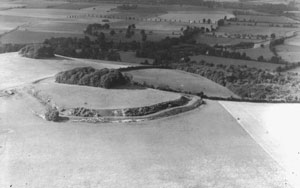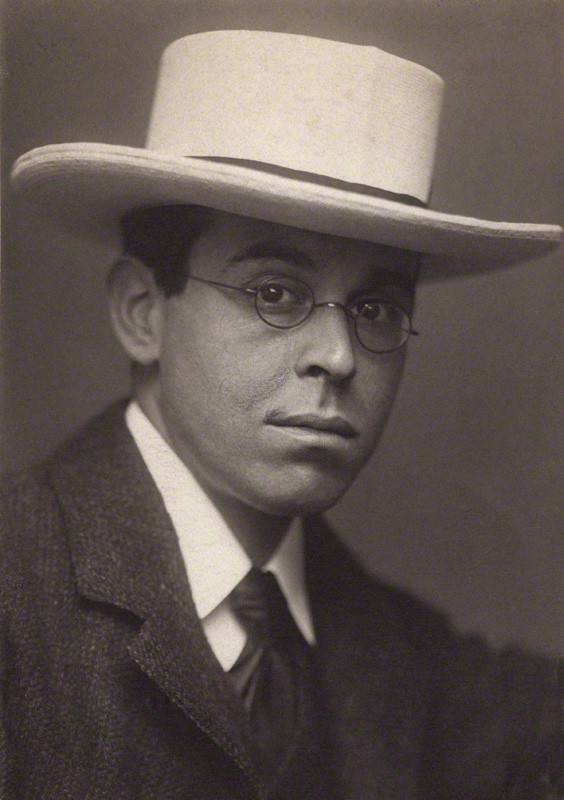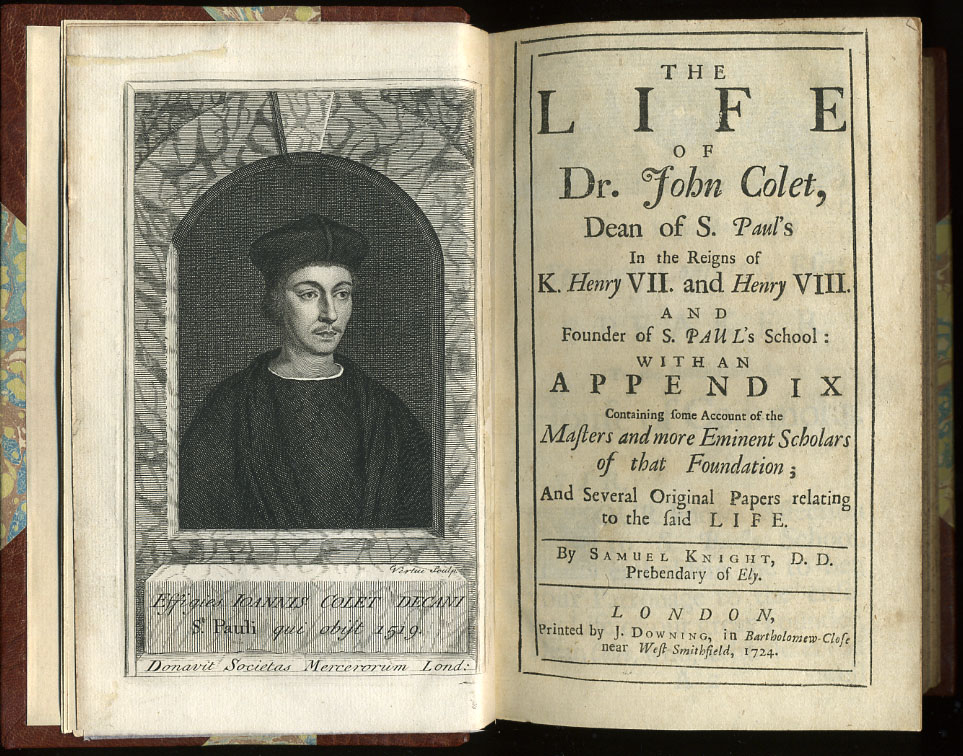|
Paul Nash (artist)
Paul Nash (11 May 1889 – 11 July 1946) was a British surrealist painter and war artist, as well as a photographer, writer and designer of applied art. Nash was among the most important landscape artists of the first half of the twentieth century. He played a key role in the development of Modernism in English art. Born in London, Nash grew up in Buckinghamshire where he developed a love of the landscape. He entered the Slade School of Art but was poor at figure drawing and concentrated on landscape painting. Nash found much inspiration in landscapes with elements of ancient history, such as burial mounds, Iron Age hill forts such as Wittenham Clumps and the standing stones at Avebury in Wiltshire. The artworks he produced during World War I are among the most iconic images of the conflict. After the war Nash continued to focus on landscape painting, originally in a formalized, decorative style but, throughout the 1930s, in an increasingly abstract and surreal manner. In his ... [...More Info...] [...Related Items...] OR: [Wikipedia] [Google] [Baidu] |
Woodcut
Woodcut is a relief printing technique in printmaking. An artist carves an image into the surface of a block of wood—typically with gouges—leaving the printing parts level with the surface while removing the non-printing parts. Areas that the artist cuts away carry no ink, while characters or images at surface level carry the ink to produce the print. The block is cut along the wood grain (unlike wood engraving, where the block is cut in the end-grain). The surface is covered with ink by rolling over the surface with an ink-covered roller (brayer), leaving ink upon the flat surface but not in the non-printing areas. Multiple colors can be printed by keying the paper to a frame around the woodblocks (using a different block for each color). The art of carving the woodcut can be called "xylography", but this is rarely used in English for images alone, although that and "xylographic" are used in connection with block books, which are small books containing text and images in t ... [...More Info...] [...Related Items...] OR: [Wikipedia] [Google] [Baidu] |
Wittenham Clumps
Wittenham Clumps are a pair of wooded chalk hills in the Thames Valley, in the civil parish of Little Wittenham, in the historic county of Berkshire, although since 1974 administered as part of South Oxfordshire district. The higher of the two, Round Hill, is above sea-level. The Castle Hill is about south-east and was the site of an Iron Age hill fort. A third hill, not normally considered one of The Clumps, is Brightwell Barrow, further to the south-east. The grassed slopes of The Clumps lead up to summits wooded by the oldest beech tree plantings in England, dating to the 1740s. Standing over 70 metres above their surroundings, the Clumps have a prominent appearance and panoramic views, with the north slopes overlooking villages and towns whose sites mark some of the first settlements of the English. The view from The Clumps was described by the artist Paul Nash, who first saw them in 1911, as "a beautiful legendary country haunted by old gods long forgotten". The Clump ... [...More Info...] [...Related Items...] OR: [Wikipedia] [Google] [Baidu] |
William Rothenstein
Sir William Rothenstein (29 January 1872 – 14 February 1945) was an English painter, printmaker, draughtsman, lecturer, and writer on art. Emerging during the early 1890s, Rothenstein continued to make art right up until his death. Though he covered many subjects – ranging from landscapes in France to representations of Jewish synagogues in London – he is perhaps best known for his work as a war artist in both world wars, his portraits, and his popular memoirs, written in the 1930s. More than two hundred of Rothenstein's portraits of famous people can be found in the National Portrait Gallery collection. The Tate Gallery also holds a large collection of his paintings, prints and drawings. Rothenstein served as Principal at the Royal College of Art from 1920 to 1935. He was knighted in 1931 for his services to art. In March 2015 'From Bradford to Benares: the Art of Sir William Rothenstein', the first major exhibition of Rothenstein's work for over forty years, opened at Bra ... [...More Info...] [...Related Items...] OR: [Wikipedia] [Google] [Baidu] |
Gordon Bottomley
Gordon Bottomley (20 February 187425 August 1948) was an English poet, known particularly for his verse dramas. He was partly disabled by tubercular illness. His main influences were the later Victorian Romantic poets, the Pre-Raphaelites and William Morris. Background Bottomley was born in Keighley, West Riding of Yorkshire on 20 February 1874, the only child of Maria and Alfred Bottomley. He was educated firstly at home by his mother and then at the local grammar school. Aged seven, Bottomley contracted a tubercular illness that would affect him for the rest of his life. As a result he was invalided for long periods of time and was unable to travel widely or live in a town. Bottomley became a junior clerk at the Craven Bank in Keighley at the age of 16. However, after an illness in 1891 he was transferred to the Bradford branch. Here he first visited the theatre and saw the Oscar Wilde play ''Lady Windermere's Fan''. This stimulated his interest in plays. Following another ... [...More Info...] [...Related Items...] OR: [Wikipedia] [Google] [Baidu] |
Selwyn Image
Selwyn Image (17 February 1849, Bodiam, Sussex – 21 August 1930, London) was an important British artist, designer, writer and poet associated with the Arts and Crafts Movement. He designed stained-glass windows, furniture, embroidery, and was an illustrator of books. Image was the seventh Slade Professor of Fine Art at Oxford from 1910 to 1916. Early life and education Selwyn Image was born in Bodiam, Sussex on 17 February 1849 to the Reverend John Image (c. 1802–1878), vicar of Bodiam and Mary Maxwell (''nee'' Hinds c. 1807–1857). He attended Marlborough College and the New College, Oxford in 1868 where he studied drawing under John Ruskin. Intending on entering the clergy and following his father as Vicar of Bodiam, Image took Holy Orders at the age of 24. He was ordained deacon in 1872, and priest the next year. He was a curate at Tottenham and later at St. Anne's, Soho. Image began studying art with A. H. Mackmurdo and Ruskin's assistant, Arthur Burgess in 1880. I ... [...More Info...] [...Related Items...] OR: [Wikipedia] [Google] [Baidu] |
Fleet Street
Fleet Street is a major street mostly in the City of London. It runs west to east from Temple Bar at the boundary with the City of Westminster to Ludgate Circus at the site of the London Wall and the River Fleet from which the street was named. The street has been an important through route since Roman times. During the Middle Ages, businesses were established and senior clergy lived there; several churches remain from this time including Temple Church and St Bride's. The street became known for printing and publishing at the start of the 16th century, and it became the dominant trade so that by the 20th century most British national newspapers operated from here. Much of that industry moved out in the 1980s after News International set up cheaper manufacturing premises in Wapping, but some former newspaper buildings are listed and have been preserved. The term ''Fleet Street'' remains a metonym for the British national press, and pubs on the street once frequented by jo ... [...More Info...] [...Related Items...] OR: [Wikipedia] [Google] [Baidu] |
Eric Kennington
Eric Henri Kennington (12 March 1888 – 13 April 1960) was an English sculptor, artist and illustrator, and an official war artist in both World Wars. As a war artist, Kennington specialised in depictions of the daily hardships endured by soldiers and airmen. In the inter-war years he worked mostly on portraits and a number of book illustrations. The most notable of his book illustrations were for T. E. Lawrence's ''Seven Pillars of Wisdom''. Kennington was also a gifted sculptor, best known for his 24th East Surrey Division War Memorial in Battersea Park, for his work on the Shakespeare Memorial Theatre in Stratford-upon-Avon and for the effigy of Lawrence at Wareham in Dorset. Biography Early life Kennington was born in Chelsea, London, the second son of the genre and portrait painter, Thomas Benjamin Kennington (1856–1916), a founder member of the New English Art Club. He was educated at St Paul's School and the Lambeth School of Art. Kennington first exhibited at t ... [...More Info...] [...Related Items...] OR: [Wikipedia] [Google] [Baidu] |
St Paul's School (London)
(''By Faith and By Learning'') , established = , closed = , type = Independent school Public school , religion = Church of England , president = , head_label = High Master , head = Sally Anne Huang , r_head_label = Surmaster , r_head = Fran Clough , chair_label = Chairman of the Governors , chair = Johnny Robertson , founder = John Colet , specialist = , address = Lonsdale Road , city = Barnes , county = London , country = United Kingdom , postcode = SW13 9JT , local_authority = , urn = 102942 , ofsted = , staff = c. 110 , enrolment = c.950 , gender = Boys ... [...More Info...] [...Related Items...] OR: [Wikipedia] [Google] [Baidu] |
David Boyd Haycock
David Boyd Haycock (born 1968 in Banbury, Oxfordshire) is a British writer, curator and lecturer. He read 'Modern History' at St John's College, Oxford, and has an MA in the History of Art from the University of Sussex and a PhD in History from Birkbeck College, London. He is the author of a number of books, including ''William Stukeley: Science, Archaeology and Religion in Eighteenth Century England'' (2002) ''Paul Nash'' (2002, 2nd edition 2016), ''Mortal Coil: A Short History of Living Longer'' (2008) and ''A Crisis of Brilliance: Five Young British Artists and the Great War'' (2009), a group biography of the artists Paul Nash, Stanley Spencer, Mark Gertler, Dora Carrington and C.R.W. Nevinson, all of whom were students together at the Slade School of Art in London. He lives in Oxford. ''A Crisis of Brilliance'' was nominated in the "Best Non-Fiction Book" category at the 2010 Writers' Guild of Great Britain awards. An exhibition based on the book was held at Dulwich Picture G ... [...More Info...] [...Related Items...] OR: [Wikipedia] [Google] [Baidu] |
Iver Heath
Iver is a large civil parish in Buckinghamshire, England. In addition to the central clustered village, the parish includes the residential neighbourhoods of Iver Heath and Richings Park. Geography, transport and economy Part of the 43-square-mile Colne Valley regional park, with woods, lakes and land by the Grand Union Canal. Most of the open land is classified as Metropolitan Green Belt. Surrounding the Ivers are neighbouring villages and towns of Fulmer, Denham, Gerrards Cross and Wexham. Also nearby are, Langley and Slough in Berkshire and Uxbridge, Cowley, Yiewsley and West Drayton in Hillingdon. The Ivers are well connected, with public transport and motorway links. Nearest motorway links are Junction 15 and 16 M25 motorway, Junction 4 and 5 M4 motorway, including the Thorney Interchange, whereby to the North of the Ivers is Junction 1 M40 motorway as well as the A40, which is parallel to the M40. With the Great Western Main line and soon Crossrail (Elizabe ... [...More Info...] [...Related Items...] OR: [Wikipedia] [Google] [Baidu] |
Earl's Court
Earl's Court is a district of Kensington in the Royal Borough of Kensington and Chelsea in West London, bordering the rail tracks of the West London line and District line that separate it from the ancient borough of Fulham to the west, the sub-districts of South Kensington to the east, Chelsea to the south and Kensington to the northeast. It lent its name to the now defunct eponymous pleasure grounds opened in 1887 followed by the pre–World War II Earls Court Exhibition Centre, as one of the country's largest indoor arenas and a popular concert venue, until its closure in 2014. In practice, the notion of Earl's Court, which is geographically confined to the SW5 postal district, tends to apply beyond its boundary to parts of the neighbouring Fulham area with its SW6 and W14 postcodes to the west, and to adjacent streets in postcodes SW7, SW10 and W8 in Kensington and Chelsea. Earl's Court is also an electoral ward of the local authority, Kensington and Chelsea London Bor ... [...More Info...] [...Related Items...] OR: [Wikipedia] [Google] [Baidu] |
John Nash (artist)
John Northcote Nash (11 April 1893 – 23 September 1977) was a British painter of landscapes and still-lives, and a wood engraver and illustrator, particularly of botanic works. He was the younger brother of the artist Paul Nash (artist), Paul Nash. Early life Nash was born in London, the younger son of lawyer William Harry Nash who served as recorder (judge), recorder of Abingdon-on-Thames, Abingdon and Caroline Maude Jackson. His mother came from a family with a naval tradition; she was mentally unstable and died in a mental asylum in 1910. In 1901 the family moved to Iver Heath, Buckinghamshire. Nash was educated at Langley, Berkshire, Langley Place in Slough and afterwards at Wellington College, Berkshire. He particularly enjoyed botany, but was unsure which career path to take. At first he worked as a newspaper reporter for the ''Middlesex and Berkshire Gazette'', in 1910. His brother became a student at the Slade School of Art the same year, and through his brother P ... [...More Info...] [...Related Items...] OR: [Wikipedia] [Google] [Baidu] |
_(Art._IWM_ART_1154).jpg)




.jpg)
_(Art.IWM_ART_15661).jpg)


